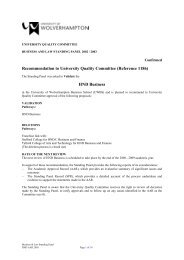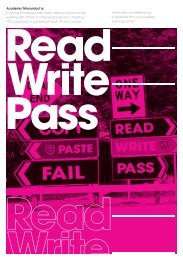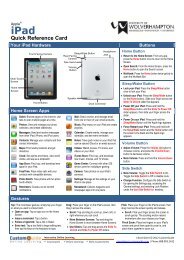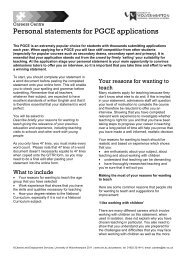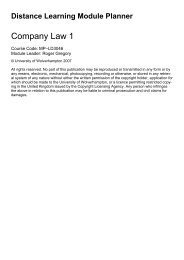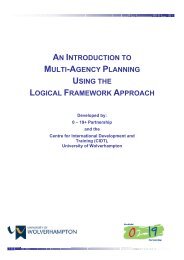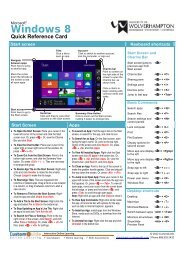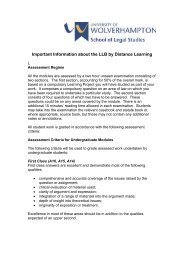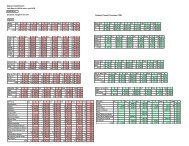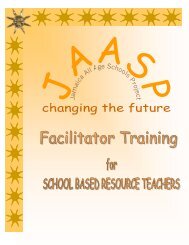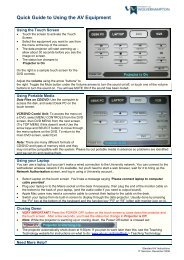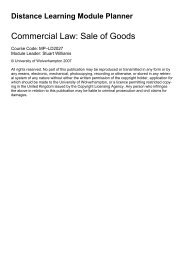Guidelines for Marking the work of Students who - University of ...
Guidelines for Marking the work of Students who - University of ...
Guidelines for Marking the work of Students who - University of ...
- No tags were found...
Create successful ePaper yourself
Turn your PDF publications into a flip-book with our unique Google optimized e-Paper software.
Student Enabling Centre: Dyslexia UnitDyslexia Assessment PolicyTable <strong>of</strong> Contents1. Background in<strong>for</strong>mation on dyslexia...........................................................22. Rationale <strong>for</strong> <strong>the</strong> introduction <strong>of</strong> <strong>the</strong>se assessment guidelines ................23. Circumstances under which special assessment guidelines should beapplied .................................................................................................................44. Identifying circumstances <strong>for</strong> applying <strong>the</strong> guidelines ..............................55. Misuse <strong>of</strong> stickers issued to students with dyslexia ..................................66. Assessing written course<strong>work</strong> and written examination responses ........67. Providing feedback on written assignments and written examinationresponses............................................................................................................78. Assessing oral presentations......................................................................89. Common errors related to dyslexia.............................................................910. Extensions <strong>for</strong> <strong>the</strong> submission <strong>of</strong> course<strong>work</strong> ........................................1011. The right <strong>of</strong> students with dyslexia to appeal in accordance with <strong>the</strong>semarking guidelines ..........................................................................................1112. Special examination arrangements <strong>for</strong> students with dyslexia ..............1213. Confidentiality <strong>of</strong> in<strong>for</strong>mation relating to students with dyslexia...........13Page 1 <strong>of</strong> 13
1. Background in<strong>for</strong>mation on dyslexiaDyslexia is one <strong>of</strong> several conditions described as a specific learning difficulty,meaning that difficulties are present in particular areas <strong>of</strong> learning but thatgeneral intelligence is not adversely affected. Evidence suggests that <strong>the</strong>re is agenetic explanation and researchers have also established that dyslexia has aneurological basis. Individuals may be born with <strong>the</strong> condition (developmentaldyslexia) or may develop a <strong>for</strong>m <strong>of</strong> dyslexia through head injury or neurologicaltrauma (acquired dyslexia).The ‘deficit model’ <strong>of</strong> dyslexia emphasises underlying problems with short-termmemory, in<strong>for</strong>mation processing and phonological awareness and focuses onassociated difficulties with literacy and <strong>the</strong> recall <strong>of</strong> rote in<strong>for</strong>mation. Equallyimportant to consider, however, are <strong>the</strong> range <strong>of</strong> strengths and sophisticatedskills that an individual with dyslexia may possess, such as lateral reasoning,creative thinking, three-dimensional visualisation and an intuitive, holisticapproach to problem-solving.Dyslexia is best understood as an unusual balance <strong>of</strong> strengths and difficultiesthat will not limit <strong>the</strong> opportunities <strong>of</strong> an individual if adjustments are made toreflect his/her different cognitive abilities. From an equal opportunitiesperspective, adjustments are required in methods <strong>of</strong> teaching, learning andassessment in order to develop and maintain an inclusive learning environment<strong>for</strong> students <strong>who</strong> have dyslexia.2. Rationale <strong>for</strong> <strong>the</strong> introduction <strong>of</strong> <strong>the</strong>se assessmentguidelinesThese guidelines help address recommendations within both <strong>the</strong> QAA Code <strong>of</strong>Practice and also Part 4 <strong>of</strong> <strong>the</strong> Disability Discrimination Act (DDA). The QAACode <strong>of</strong> Practice <strong>for</strong> <strong>the</strong> assurance <strong>of</strong> academic quality and standards in highereducation gives higher education institutions clear guidance on provision <strong>for</strong>students with disabilities. The object <strong>of</strong> <strong>the</strong> code is to assist institutions inensuring that students with disabilities have access to a learning experiencecomparable to that <strong>of</strong> <strong>the</strong>ir peers.Part 4 <strong>of</strong> <strong>the</strong> DDA states that discrimination against disabled applicants orstudents can take place by ei<strong>the</strong>r treating <strong>the</strong>m ‘less favourably’ than o<strong>the</strong>rs, orPage 2 <strong>of</strong> 13
y failing to make a ‘reasonable adjustment’ when <strong>the</strong>y are placed at a‘substantial disadvantage’ compared to o<strong>the</strong>r students <strong>for</strong> a reason relating to<strong>the</strong>ir disability. A reasonable adjustment would involve taking action to alleviate asubstantial disadvantage, which could mean changing standard institutionalprocedures. The Disability Rights Commission suggest a number <strong>of</strong>modifications <strong>for</strong> students with dyslexia, including <strong>the</strong> use <strong>of</strong> alternativeassessment tasks, deadline extensions, <strong>the</strong> provision <strong>of</strong> additional technologicaland human support and considerate marking. These recommendations willrequire action to be taken by academic staff as well as by <strong>the</strong> Student EnablingCentre.The Student Enabling Centre helps students with dyslexia to access varioussupport mechanisms to alleviate <strong>the</strong>ir basic skills difficulties, such as <strong>the</strong> use <strong>of</strong>enabling equipment and specialist study skills tuition. However, <strong>the</strong>re arevariations and inconsistencies in <strong>the</strong> capacity <strong>for</strong> individuals to access <strong>the</strong>seservices. Some students are not eligible <strong>for</strong> funded support. Those students <strong>who</strong>are eligible may find <strong>the</strong> process <strong>of</strong> liaising with external agencies to complete<strong>the</strong> complicated process <strong>of</strong> accessing support takes several months. In addition,many students are identified as having dyslexia each year at <strong>the</strong> <strong>University</strong> <strong>of</strong>Wolverhampton and <strong>the</strong>se students also have to wait <strong>for</strong> support to be arrangedin accordance with <strong>the</strong> DfES funding system. Even students <strong>who</strong> receiveequipment and specialist tuition may struggle to manage <strong>the</strong>ir time to make fulluse <strong>of</strong> <strong>the</strong>se mechanisms <strong>for</strong> pro<strong>of</strong> reading assignments. It is likely, <strong>the</strong>re<strong>for</strong>e,that some students with dyslexia will be unable to submit written <strong>work</strong> that is free<strong>of</strong> errors on a consistent basis.Staff within <strong>the</strong> Student Enabling Centre act as swiftly as possible whenarranging support <strong>for</strong> disabled students, but external constraints exist due to <strong>the</strong>nature <strong>of</strong> <strong>the</strong> funding system. As difficulties with <strong>the</strong> accuracy <strong>of</strong> grammar,spelling and punctuation are directly related to <strong>the</strong> impairments associated withdyslexia and <strong>the</strong>se place <strong>the</strong> student at a substantial disadvantage, a markingpolicy <strong>for</strong> students with dyslexia is conducive to <strong>of</strong>fering <strong>the</strong>se students equality<strong>of</strong> opportunity.This policy is not intended to replace support currently available to students withdyslexia, but ra<strong>the</strong>r <strong>the</strong> Student Enabling Centre will continue to strive towardsimproved services <strong>for</strong> students. Nor is <strong>the</strong> policy intended to deliver favourabletreatment to students with dyslexia in comparison to <strong>the</strong>ir non-dyslexic peers, butra<strong>the</strong>r its purpose is to <strong>of</strong>fer a reasonable adjustment to standard assessmentprocedures to take account <strong>of</strong> <strong>the</strong> reality <strong>of</strong> <strong>the</strong>ir disability. Fur<strong>the</strong>rmore, thispolicy is not intended to en<strong>for</strong>ce <strong>the</strong> lowering <strong>of</strong> academic standards within <strong>the</strong>university. In accordance with Part 4 <strong>of</strong> <strong>the</strong> DDA, this policy allows academicstandards, in this case relating to <strong>the</strong> quality <strong>of</strong> basic skills, to be upheld wherenecessary.Page 3 <strong>of</strong> 13
The rationale <strong>for</strong> <strong>the</strong> introduction <strong>of</strong> this policy is to maintain equality <strong>of</strong>opportunity <strong>for</strong> students with dyslexia in respect to <strong>the</strong> assessment <strong>of</strong>course<strong>work</strong>.3. Circumstances under which special assessmentguidelines should be applied1. This marking policy should be applied to <strong>the</strong> assessment <strong>of</strong> all submittedwritten <strong>work</strong> and examination or test scripts that are produced by astudent <strong>who</strong> you have been in<strong>for</strong>med has dyslexia. There is also anaspect <strong>of</strong> this policy that should be applied to <strong>the</strong> assessment <strong>of</strong> an oralpresentation.2. The only circumstance that overrides point 1 above is when a corerequirement has been established as a necessary learning outcome <strong>for</strong>assessment and this core requirement conflicts with <strong>the</strong> ability to followcertain guidelines in this document. However, <strong>the</strong>se guidelines should stillbe followed as closely as possible, only excluding recommendations withinthis document that conflict with specified core requirements.3. If a core requirement exists that conflicts with this marking policy, thisshould be detailed within <strong>the</strong> module specification template and both <strong>the</strong>relevant dyslexic student and <strong>the</strong> Special Needs Tutor <strong>for</strong> <strong>the</strong> schoolshould be made aware <strong>of</strong> this circumstance.4. Decisions to specify a core requirement that disallows students withdyslexia access to certain marking concessions outlined in this documentshould be clarified with caution. There should be clear, justifiable reasonsthat relate to academic standards and that could not be seen asdiscriminatory practice. For example, if an issue <strong>of</strong> pr<strong>of</strong>essional training orcompetency is considered a reason <strong>for</strong> upholding basic skills as a corerequirement, it is advisable to check that <strong>the</strong> relevant pr<strong>of</strong>essional bodyactively supports this decision.5. Ideally, <strong>the</strong> relevant dyslexic student and <strong>the</strong> Special Needs Tutor <strong>for</strong> <strong>the</strong>school should be made aware <strong>of</strong> <strong>the</strong> conflict detailed in point 3 above at<strong>the</strong> time an assignment brief is issued and both parties should be madeaware <strong>of</strong> which exclusions are to be applied.6. Written feedback provided <strong>for</strong> <strong>the</strong> assignment or examination script shouldclearly state why <strong>the</strong>se marking guidelines were only partially applied andPage 4 <strong>of</strong> 13
should clearly state <strong>the</strong> exclusions that were made in accordance with <strong>the</strong>core requirements <strong>for</strong> <strong>the</strong> assessment <strong>of</strong> <strong>the</strong> written <strong>work</strong> in question.4. Identifying circumstances <strong>for</strong> applying <strong>the</strong>guidelines:1. The student has attached a sticker to an assignment that has beensubmitted. <strong>Students</strong> <strong>who</strong> wish to ensure discretion when handing in <strong>work</strong>may place this sticker inside <strong>the</strong> assignment. The sticker will state,‘Please refer to <strong>the</strong> Dyslexia Assessment Policy when marking this <strong>work</strong>.’2. The student has verbally in<strong>for</strong>med you that s/he has dyslexia and youhave verified <strong>the</strong> accuracy <strong>of</strong> this in<strong>for</strong>mation by contacting <strong>the</strong> SpecialNeeds Tutor <strong>for</strong> <strong>the</strong> school.3. The Special Needs Tutor <strong>for</strong> <strong>the</strong> school has in<strong>for</strong>med you that <strong>the</strong> studenthas dyslexia.4. A member <strong>of</strong> staff from <strong>the</strong> Assessment & Conferment Unit has in<strong>for</strong>medyou that <strong>the</strong> student has dyslexia.5. A member <strong>of</strong> staff from <strong>the</strong> Student Enabling Centre has in<strong>for</strong>med you that<strong>the</strong> student has dyslexia.6. The student has enclosed a Tutor Awareness Sheet with <strong>the</strong> assignmentor has previously handed you a copy <strong>of</strong> this document.7. Please note that in <strong>the</strong> circumstances outlined in sections 4.2 – 4.5 above,a sticker may not have been used to identify <strong>the</strong> students’ <strong>work</strong> but <strong>the</strong>marking guidelines should still be applied. In practice, <strong>the</strong>re may be aninterim period where in<strong>for</strong>mation about <strong>the</strong> introduction <strong>of</strong> <strong>the</strong> stickersystem has not been disseminated to every student with dyslexia within<strong>the</strong> university. Special Needs tutors and academic staff can help raiseawareness by recommending that students within categories 4.2 – 4.5above, should contact <strong>the</strong> Student Enabling Centre to obtain stickers <strong>for</strong><strong>the</strong>ir future assignments.Page 5 <strong>of</strong> 13
5. Misuse <strong>of</strong> stickers issued to students with dyslexia1. <strong>Students</strong> will only be able to obtain stickers from <strong>the</strong> Student EnablingCentre. A sheet <strong>of</strong> stickers will be issued upon request from a student<strong>who</strong> has submitted a valid assessment report <strong>for</strong> dyslexia. <strong>Students</strong> withdyslexia <strong>who</strong> have identified <strong>the</strong>mselves to <strong>the</strong> Student Enabling Centrewill be issued with in<strong>for</strong>mation on accessing all services from <strong>the</strong> StudentEnabling Centre, including stickers <strong>for</strong> <strong>the</strong> submission <strong>of</strong> written <strong>work</strong>.2. A serial number will be visible on each sticker that can be traced to <strong>the</strong>student <strong>who</strong> was issued with <strong>the</strong> stickers but if you have any concernsabout au<strong>the</strong>nticity, <strong>the</strong> Student Enabling Centre will be able to verify that<strong>the</strong> student in question has dyslexia.3. If you suspect a student <strong>who</strong> does not have dyslexia has inappropriatelyused a sticker upon submitted <strong>work</strong>, this can be investigated by <strong>the</strong>academic staff within <strong>the</strong> school <strong>who</strong> can decide upon <strong>the</strong> appropriateaction to take. It will be possible to trace <strong>the</strong> student <strong>who</strong> provided <strong>the</strong>misused stickers through <strong>the</strong> serial number, which will be registered within<strong>the</strong> Student Enabling Centre.4. When issued with stickers, students will be in<strong>for</strong>med that misuse <strong>of</strong> <strong>the</strong>sestickers will be considered academic misconduct and that <strong>the</strong>ir academicschool may take action under <strong>the</strong>se circumstances. However, onlystudents with significant basic skills difficulties are likely to benefit through<strong>the</strong> use <strong>of</strong> <strong>the</strong>se stickers, which may make misuse unlikely.6. Assessing written course<strong>work</strong> and writtenexamination responses1. The purpose <strong>of</strong> assessing <strong>the</strong> written <strong>work</strong> <strong>of</strong> dyslexic students is to avoidpenalising him/her <strong>for</strong> mistakes made with grammar, spelling andpunctuation.2. Establish <strong>the</strong> learning outcomes <strong>for</strong> <strong>the</strong> assignment in question. Mark <strong>the</strong><strong>work</strong> with <strong>the</strong> intention <strong>of</strong> giving credit <strong>for</strong> <strong>the</strong> student’s achievements inmeeting <strong>the</strong>se learning outcomes by focusing on <strong>the</strong> content andunderstanding <strong>of</strong> <strong>the</strong> topic ra<strong>the</strong>r than concentrating on written expression.Page 6 <strong>of</strong> 13
Reading <strong>the</strong> student’s <strong>work</strong> quickly can sometimes increase <strong>the</strong> ability t<strong>of</strong>ocus on content ra<strong>the</strong>r than errors.3. It is not necessary to pro<strong>of</strong>-read and correct <strong>the</strong> student’s <strong>work</strong>. However,if <strong>the</strong> spelling, punctuation and grammatical mistakes detract significantlyfrom <strong>the</strong> content <strong>of</strong> <strong>the</strong> <strong>work</strong>, it may be appropriate to begin marking bypro<strong>of</strong>-reading <strong>the</strong> assignment and making necessary corrections tospelling, grammar and punctuation. It is preferable to use pencil or blackink <strong>for</strong> <strong>the</strong>se corrections. To avoid over-emphasising mistakes, onlycorrect repetitive errors <strong>for</strong> part <strong>of</strong> <strong>the</strong> <strong>work</strong>. (To gain fur<strong>the</strong>r details onareas this should encompass, see Section 9: Common errors related todyslexia.)4. Mark <strong>the</strong> student’s <strong>work</strong> using a different colour <strong>of</strong> ink without penalising<strong>for</strong> any mistakes that have been corrected in black ink or pencil.5. If <strong>the</strong> general policy or practice within a certain course is to avoid makingwritten comments upon a students’ actual assignment, this should alsoapply to <strong>work</strong> submitted by a student with dyslexia.6. It is recognised that in some instances, <strong>the</strong> grammatical construction orwritten style <strong>of</strong> expression may obscure <strong>the</strong> clarity <strong>of</strong> <strong>the</strong> student’s ideas.In <strong>the</strong>se cases, decide whe<strong>the</strong>r <strong>the</strong> intended content can be understoodand give credit accordingly <strong>for</strong> this aspect <strong>of</strong> <strong>the</strong> <strong>work</strong>.7. In <strong>the</strong> event that a student with dyslexia is still experiencing a significantdisadvantage in producing written course<strong>work</strong> in spite <strong>of</strong> <strong>the</strong> aboveconcessions, an alternative assignment method may be appropriate <strong>for</strong><strong>the</strong> module assessment. A student can discuss this issue with his or herSpecial Needs Tutor, <strong>who</strong> will liaise with <strong>the</strong> relevant academic staff todiscuss suitable arrangements. This will take account <strong>of</strong> <strong>the</strong> individualcourse and allow consideration <strong>for</strong> <strong>the</strong> maintenance <strong>of</strong> academicstandards.7. Providing feedback on written assignments andwritten examination responses1. Written feedback should be provided considerately to avoid damaging <strong>the</strong>student’s self-esteem. <strong>Students</strong> with dyslexia can sometimes perceiveany criticism <strong>of</strong> <strong>the</strong>ir written <strong>work</strong> as disparaging and negative feedbackprovided <strong>for</strong> assignments can be more distressing to <strong>the</strong>se students than<strong>the</strong> actual mark awarded <strong>for</strong> <strong>the</strong> <strong>work</strong>. Comment as far as possible on <strong>the</strong>Page 7 <strong>of</strong> 13
strengths <strong>of</strong> <strong>the</strong> student’s <strong>work</strong> and try <strong>the</strong> ‘sandwich technique’ whenproviding feedback (positive comments/constructive advice <strong>for</strong>improvement/positive comments).2. <strong>Students</strong> with dyslexia <strong>of</strong>ten have difficulty reading cursive script, so aimto keep handwriting as legible as possible. Alternatively, feedback can beword processed and attached to <strong>the</strong> student’s <strong>work</strong>.3. Certain symbols used <strong>for</strong> marking can be perceived as critical and canconfuse students with dyslexia, <strong>for</strong> example, crosses, question marks andexclamation marks when used without sufficient explanations to establish<strong>the</strong> reason <strong>for</strong> <strong>the</strong>ir use.4. If any core requirements have been established that conflict with <strong>the</strong> abilityto fully apply <strong>the</strong>se marking guidelines, this should be stated in <strong>the</strong>feedback that is provided on an assignment or examination script.8. Assessing oral presentations1. The purpose <strong>of</strong> assessing oral presentations by dyslexic students is toavoid penalising him/her <strong>for</strong> mistakes made with grammar, spelling andpunctuation or with speech production.2. Establish <strong>the</strong> learning outcomes <strong>for</strong> <strong>the</strong> oral presentation in question.Mark <strong>the</strong> <strong>work</strong> with <strong>the</strong> intention <strong>of</strong> giving credit <strong>for</strong> <strong>the</strong> student’sachievements in meeting <strong>the</strong>se learning outcomes by focusing on <strong>the</strong>content and understanding <strong>of</strong> <strong>the</strong> topic. Avoid penalising <strong>the</strong> student <strong>for</strong>mistakes with <strong>the</strong> pronunciation <strong>of</strong> words, <strong>for</strong> misreading from <strong>the</strong> visualaids or <strong>for</strong> basic skills errors on visual aids or handouts.3. Although some students with dyslexia favour oral presentations as anassessment method, o<strong>the</strong>rs experience anxiety or even phobic reactions.Where <strong>the</strong>se negative feelings occur, <strong>the</strong>y can sometimes be linked tohumiliating experiences <strong>of</strong> reading aloud at school.4. Where a student with dyslexia has a significantly high level <strong>of</strong> anxiety overoral presentations, <strong>of</strong>fer support and reassurance where possible. Inextreme cases <strong>of</strong> anxiety or phobia, alternative methods can be explored,such as allowing <strong>the</strong> student to submit a video recording <strong>of</strong> his or herpresentation or allowing <strong>the</strong> presentation to be made directly to <strong>the</strong>lecturer without o<strong>the</strong>r students present. This can be considered an interimPage 8 <strong>of</strong> 13
measure if <strong>the</strong> student is willing to participate fully once his or herconfidence has increased.9. Common errors related to dyslexia1. Although <strong>the</strong> primary aim <strong>of</strong> this marking policy is to avoid penalisingstudents <strong>for</strong> mistakes made with spelling, punctuation and grammar, o<strong>the</strong>rdyslexia-related errors can also impair <strong>the</strong> quality <strong>of</strong> a student’s written<strong>work</strong>. The main difficulties are presented here to allow you to recogniseerrors that may be dyslexia-related. A service <strong>for</strong> screening andassessing students <strong>for</strong> dyslexia is available in <strong>the</strong> Student Enabling Centreand it may be appropriate to in<strong>for</strong>m students <strong>of</strong> this provision where <strong>the</strong>irerrors fall into <strong>the</strong> categories below.2. Spelling errors are <strong>of</strong>ten evident and may include: erratic and inconsistentspelling where words can be spelt in several different ways in <strong>the</strong> samedocument; inappropriate use <strong>of</strong> phonetic spelling choices (eny/anyordeance/audience); misuse <strong>of</strong> spell check facility leading to incorrectlyselected words (sublimely perception instead <strong>of</strong> subliminal perception);misspelling proper names such as <strong>the</strong> names <strong>of</strong> researchers; telescopingpolysyllabic words (rembered/remembered); misuse <strong>of</strong> homophones(to/too), and letter reversals (dose/does).3. Punctuation and grammatical mistakes can be present in written <strong>work</strong> andmay include: misuse or omission <strong>of</strong> punctuation marks; failure to identifysentence boundaries with possible overuse <strong>of</strong> conjunctions; short,unsophisticated sentences lacking in complexity, and inappropriategrammatical constructions4. General presentation skills may be poor even when <strong>work</strong> has beenproduced through <strong>the</strong> use <strong>of</strong> computer packages.5. The following problems can be present with handwritten <strong>work</strong>: untidyhandwriting or <strong>the</strong> inability to use cursive style; confusion <strong>of</strong> visuallysimilar letters (b/d, p/q), and <strong>the</strong> misuse <strong>of</strong> capital letters which issometimes used as a strategy to select b/d correctly (consiDeraBle). Anyadditional pressures with time or stress, such as writing quickly in lecturesor an examination situation, can cause handwriting to deteriorate fur<strong>the</strong>r.6. There may be difficulties in expressing ideas in a conventional academicstyle <strong>of</strong> writing and written constructions may be unsophisticated.Page 9 <strong>of</strong> 13
7. <strong>Students</strong> with dyslexia may digress from <strong>the</strong> assignment topic by ei<strong>the</strong>rincluding in<strong>for</strong>mation that is irrelevant or expanding unnecessarily onpoints <strong>of</strong> minor importance. Sometimes unusual links between topics aremade that reflect a student’s lateral and creative thinking skills but do notmeet <strong>the</strong> learning outcomes. Even though it will not be possible to awardmarks <strong>for</strong> such digressions, it can be supportive to acknowledge <strong>the</strong>student’s research attempts when providing written feedback.8. Written <strong>work</strong> can lack structure at <strong>the</strong> level <strong>of</strong> both sentences andparagraphs leading to a repetition <strong>of</strong> in<strong>for</strong>mation in different parts <strong>of</strong> <strong>the</strong><strong>work</strong> and a failure to develop a sustained and detailed discussion.9. A student with dyslexia may find it difficult to express his/her ideas in aconventional academic written <strong>for</strong>mat and may find it difficult to attain <strong>the</strong>recommended word limit.10. <strong>Students</strong> with dyslexia <strong>of</strong>ten spend considerably more time on assignmentproduction than <strong>the</strong>ir non-dyslexic peers, but this ef<strong>for</strong>t is not alwaysreflected in <strong>the</strong>ir written <strong>work</strong>. Sometimes <strong>the</strong>re may be a markeddifference between <strong>the</strong> student’s abilities as demonstrated in oraldiscussions and that indicated by written expression.11. <strong>Students</strong> with dyslexia can have speech and language difficulties thataffect <strong>the</strong> pronunciation <strong>of</strong> words. Some experience a stammer whenunder pressure and this can cause high levels anxiety in <strong>for</strong>mal speakingsituations, such as oral presentations.10. Extensions <strong>for</strong> <strong>the</strong> submission <strong>of</strong> course<strong>work</strong>1. It is recommended that wherever possible lecturers give consideration torequests <strong>for</strong> extensions <strong>for</strong> <strong>the</strong> submission <strong>of</strong> course<strong>work</strong> from studentswith dyslexia.2. The length <strong>of</strong> <strong>the</strong> extension is at <strong>the</strong> lecturer’s discretion and should takeaccount <strong>of</strong> <strong>the</strong> student’s individual circumstances although, as a guideline,an extension ranging from 7 – 14 days could be considered reasonable.3. When a student with dyslexia requests an extension on a submissiondeadline, it is recommended that lecturers consider granting <strong>the</strong> extensionwhere <strong>the</strong> student has made reasonable ef<strong>for</strong>ts to meet <strong>the</strong> deadline andwhere <strong>the</strong>re appears a genuine reason <strong>for</strong> non-submission. The generalPage 10 <strong>of</strong> 13
difficulties with time management and study skills that are characteristic <strong>of</strong>dyslexia may be considered a sufficient reason to grant an extension, if<strong>the</strong> student has demonstrated that he or she has made reasonable ef<strong>for</strong>tstowards completing <strong>the</strong> assignment. Any supporting evidence from o<strong>the</strong>rindividuals such as <strong>the</strong> student’s dyslexia study skills tutor (if s/he hasone) or <strong>the</strong> special needs tutor can be taken into account. However, alecturer can refuse to grant an extension if <strong>the</strong>re does not appear to be areasonable excuse <strong>for</strong> missing <strong>the</strong> deadline.4. A student with dyslexia should apply <strong>for</strong> an extension by completing <strong>the</strong>standard <strong>for</strong>m and may choose to attach a sticker to verify s/he hasdyslexia. Wherever possible, however, <strong>the</strong> lecturer should in<strong>for</strong>m <strong>the</strong>student that this is <strong>the</strong> correct procedure.11. The right <strong>of</strong> students with dyslexia to appeal inaccordance with <strong>the</strong>se marking guidelines1. If a student <strong>who</strong> has dyslexia believes his/her <strong>work</strong> has not been markedin accordance with <strong>the</strong> guidelines outlined in this document, s/he canfollow <strong>the</strong> normal procedures <strong>for</strong> requesting second-marking by a differentmember <strong>of</strong> academic staff.2. A dyslexic student will not have <strong>the</strong> right to appeal against penalisation <strong>for</strong>failing to meet core requirements that have been established as markingcriteria and <strong>of</strong> which <strong>the</strong> student has been in<strong>for</strong>med within <strong>the</strong> writtenfeedback <strong>for</strong> <strong>the</strong> assessment.3. These assessment guidelines only apply from <strong>the</strong> date on which <strong>the</strong>ybecame <strong>for</strong>mally introduced. <strong>Students</strong> with dyslexia do not have <strong>the</strong> rightto request re-marking or re-grading <strong>of</strong> <strong>work</strong> marked prior to <strong>the</strong>introduction <strong>of</strong> <strong>the</strong>se guidelines.4. <strong>Students</strong> <strong>who</strong> are identified as having dyslexia through <strong>for</strong>mal assessmentwhilst studying at <strong>the</strong> university are not entitled to have course<strong>work</strong> remarkedthat <strong>the</strong>y submitted be<strong>for</strong>e <strong>the</strong>ir dyslexia was identified. However,if such a student submits a claim <strong>for</strong> extenuating circumstances, it isappropriate to take into account that s/he has been studying withunidentified dyslexia and has <strong>the</strong>re<strong>for</strong>e not received relevant support.Page 11 <strong>of</strong> 13
12. Special examination arrangements <strong>for</strong> studentswith dyslexia1. A student with dyslexia may have recommendations <strong>for</strong> specialexamination arrangements, such as additional time, a reader/amanuensisor <strong>the</strong> use <strong>of</strong> a word processor.2. Where a support <strong>work</strong>er acts as a reader/amanuensis, <strong>the</strong> student withdyslexia should be placed in a separate room from o<strong>the</strong>r candidates. Forexaminations that take place in <strong>the</strong> main examination weeks, <strong>the</strong>Assessment and Conferment Unit will arrange <strong>for</strong> invigilators to bepresent. For internal tests or examinations, it is <strong>the</strong> responsibility <strong>of</strong> <strong>the</strong>module tutor to ensure s/he is satisfied that appropriate examinationconditions have been arranged. It should be noted that a support <strong>work</strong>ercould not be expected to take a dual role and also act as an invigilator.3. When extra time is granted, this will usually be 25%, which is equivalent toan extra 15 minutes <strong>for</strong> each hour.4. If possible, a student with dyslexia <strong>who</strong> is receiving extra time should beplaced in a room separate from main candidates to avoid <strong>the</strong> distraction <strong>of</strong>o<strong>the</strong>rs leaving <strong>the</strong> examination room. It is permissible <strong>for</strong> several studentsreceiving extra time to be placed in a room toge<strong>the</strong>r and this is anarrangement frequently made by <strong>the</strong> Assessment and Conferment Unit. Ifit is not possible to provide a separate room, a fur<strong>the</strong>r 10 minutes shouldbe added to <strong>the</strong> total examination time in addition to <strong>the</strong> 25% extra time.This will help compensate <strong>for</strong> <strong>the</strong> noise and distraction caused when maincandidates leave <strong>the</strong> examination room. The member <strong>of</strong> staff invigilatingshould not draw attention to <strong>the</strong> fact that a student with dyslexia willremain in <strong>the</strong> examination room, to ensure that a student’s dyslexia is notdisclosed to o<strong>the</strong>r students.5. A student with dyslexia may find his or her examination lasts an usuallylong time, due to <strong>the</strong> additional time that has been added. For this reason,s/he can request a rest break during an examination that is due to lastlonger than 4½ hours. On arrival at <strong>the</strong> examination venue, <strong>the</strong> studentshould alert <strong>the</strong> invigilator to <strong>the</strong> fact that a rest break may be requestedduring <strong>the</strong> examination and discuss how <strong>the</strong> invigilator can be alerted tothis (<strong>for</strong> example, by <strong>the</strong> student raising his or her hand). Providing morethan one invigilator is present <strong>for</strong> <strong>the</strong> examination, It would be appropriate<strong>for</strong> an invigilator to accompany a student <strong>who</strong> wishes to leave <strong>the</strong> room toensure that examination conditions continue to be met.Page 12 <strong>of</strong> 13
5. In <strong>the</strong> event that a student with dyslexia is still experiencing a significantdisadvantage in undertaking examinations in spite <strong>of</strong> <strong>the</strong> aboveconcessions, an alternative assignment method may be appropriate <strong>for</strong><strong>the</strong> module assessment. A student can discuss this issue with his or herSpecial Needs Tutor, <strong>who</strong> will liaise with <strong>the</strong> relevant academic staff todiscuss suitable arrangements. This will take account <strong>of</strong> <strong>the</strong> individualcourse and allow consideration <strong>for</strong> <strong>the</strong> maintenance <strong>of</strong> academicstandards.13. Confidentiality <strong>of</strong> in<strong>for</strong>mation relating to studentswith dyslexia1. If a student in<strong>for</strong>ms you that s/he has dyslexia, establish whe<strong>the</strong>r s/he hasmade contact with <strong>the</strong> Student Enabling Centre. Whe<strong>the</strong>r or not s/he has,it is your responsibility under Part 4 <strong>of</strong> <strong>the</strong> Disability Discrimination Act toact upon your knowledge <strong>of</strong> <strong>the</strong> student’s disability. It is appropriate toexplain this to <strong>the</strong> student and identify him/her to <strong>the</strong> Student EnablingCentre. If <strong>the</strong> student objects to you in<strong>for</strong>ming anyone <strong>of</strong> his/her dyslexia,it is advisable that you obtain this statement in writing with <strong>the</strong> student’ssignature <strong>for</strong> <strong>the</strong> legal protection <strong>of</strong> yourself and <strong>the</strong> <strong>University</strong> <strong>of</strong>Wolverhampton. It will <strong>the</strong>n be permissible to treat <strong>the</strong> in<strong>for</strong>mation inconfidence. If you are in any doubt, speak to a member <strong>of</strong> staff within <strong>the</strong>Student Enabling Centre without revealing <strong>the</strong> student’s identity.2. The fact that a student has dyslexia must not be revealed to any o<strong>the</strong>rstudent within <strong>the</strong> university. It is particularly important to be wary <strong>of</strong>discussing <strong>the</strong> student’s needs casually in public places where o<strong>the</strong>rstudents may overhear. Nor should facts about special provision <strong>for</strong> <strong>the</strong>student be mentioned in any situation where o<strong>the</strong>r students are present(<strong>for</strong> example, in<strong>for</strong>ming a student with dyslexia during a lecture that s/hecan have extra time <strong>for</strong> an examination), as this will effectively reveal <strong>the</strong>special needs to o<strong>the</strong>r students.3. If you need to discuss issues relating to <strong>the</strong> student’s dyslexia with o<strong>the</strong>rmembers <strong>of</strong> staff, in<strong>for</strong>m <strong>the</strong> student that you propose to do this andconfirm that s/he is in agreement. If <strong>the</strong> student is not in agreement, <strong>the</strong>nconfidentiality can only be broken if a health and safety issue is at stake.Where circumstances allow, it may be appropriate to discuss <strong>the</strong> issuewithout revealing <strong>the</strong> student’s identity.Page 13 <strong>of</strong> 13



